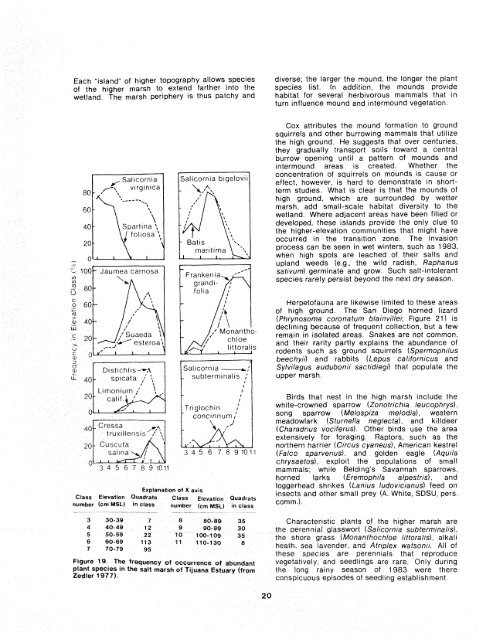The Ecology of Tijuana Estuary, California: An Estuarine Profile
The Ecology of Tijuana Estuary, California: An Estuarine Profile
The Ecology of Tijuana Estuary, California: An Estuarine Profile
You also want an ePaper? Increase the reach of your titles
YUMPU automatically turns print PDFs into web optimized ePapers that Google loves.
Each "island" <strong>of</strong> higher topography allows species diverse; the larger the mound, the longer the plant<br />
<strong>of</strong> the higher marsh to extend farther into the species list. In addition, the mounds provide<br />
wetland. <strong>The</strong> marsh periphery is thus patchy and habitat for several herbivorous mammals that in<br />
turn influence mound and Intermound vegetation.<br />
Cox attributes the mound formation to ground<br />
squirrels and other burrowing mammals that utilize<br />
the high ground. He suggests that over centuries,<br />
they gradually transport so~ls toward a central<br />
burrow opening until a pattern <strong>of</strong> mounds and<br />
intermound areas is created. Whether the<br />
concentration <strong>of</strong> squirrels on mounds is cause or<br />
effect, however, is hard to demonstrate in shortterm<br />
studies. What is clear is that the mounds <strong>of</strong><br />
high ground, which are surrounded by wetter<br />
marsh, add small-scale hab~tat diversity to the<br />
wetland. Where adjacent areas have been filled or<br />
developed, these islands provide the only clue to<br />
the higher-elevation communities that might have<br />
occurred rn the transition zone. <strong>The</strong> invasion<br />
process can be seen in wet winters, such as 1983,<br />
when high spots are leached <strong>of</strong> their salts and<br />
upland weeds (e.g., the wild radish, Raphanus<br />
sativum) germinate and grow. Such salt-intolerant<br />
species rarely persist beyond the next dry season.<br />
Herpet<strong>of</strong>auna are l~kewise lim~ted to these areas<br />
<strong>of</strong> high ground. <strong>The</strong> San Diego horned lizard<br />
(Phrynosoma coronatum blainv~llei; Figure 21) is<br />
declining because <strong>of</strong> frequent collection, but a few<br />
remain in isolated areas. Snakes are not common,<br />
and their rarity partly explalns the abundance <strong>of</strong><br />
rodents such as ground squirrels (Spermoph~lus<br />
beechyid and rabbits (Lepus californicus and<br />
Sylv~lagus audubonil sactidregil that populate the<br />
upper marsh<br />
Birds that nest in the high marsh include the<br />
white-crowned sparrow (Zonotnchia leucophrys),<br />
song sparrow (Melospira melodia), western<br />
meadowlark (Sturnella neglecia), and killdeer<br />
(Charadnus vociferus). Other birds use the area<br />
extensively for foraging. Raptors, such as the<br />
northern harrier (Circus cyaneus), Amertcan kestrel<br />
1 (Falco sparverius), and golden eagle (Aquila<br />
chrysaetos), explolt the populations <strong>of</strong> small<br />
mammals; while Belding's Savannah sparrows,<br />
horned larks (Eremophila alpestris), and<br />
loggerhead shrikes (Lanius ludovic~anus) feed on<br />
Expisnation <strong>of</strong> X axis<br />
insects and other small prey (A. White, SDSU, pers.<br />
Cla~r~ Elevation Quadrats Class Elevation Quadrats comm ,,<br />
numbef (cm MSL) in crass number (cm MSL) in class<br />
" -- - .<br />
3 30-39 7 8 80-89 35 Gharacteristic plants <strong>of</strong> the higher marsh are<br />
4 40-49 f 2 B 90-99 30 the perennial glasswort (Salrcornla subterm~nalts),<br />
5 50-59 22 10 100-109 39 the shore grass (Mananthochloe Iittoral~s), alkali<br />
6 60-69 113 11 110-130 8<br />
7 70.79 95 heath, sea lavender, and Atr~plex watsoni~. Ail <strong>of</strong><br />
these specles are perenn~als that reproduce<br />
Figure 1% <strong>The</strong> frequency <strong>of</strong> occurrence <strong>of</strong> abundant vegetatively, and seedlings are rare. Only dur~ng<br />
Plant species in the salt marsh <strong>of</strong> Tljuana <strong>Estuary</strong> (from the long ralny season <strong>of</strong> 1983 were there<br />
Zedter 1977).<br />
conspicuous episodes <strong>of</strong> seedling establishment<br />
2 0

















